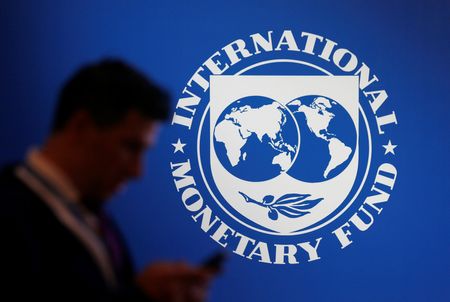By Pete Schroeder
WASHINGTON (Reuters) – The International Monetary Fund is cautioning against overexuberance in markets as investors look for central bankers to pull off a “soft landing” in their years-long inflation battle.
In its latest semi-annual Global Financial Stability Report, the IMF noted that markets have turned “quite optimistic” since the October edition, when investors were still recovering from spring turmoil in the banking sector.
Now, downside risks are receding, but the IMF is cautioning against complacency, noting that stretched valuations across a range of asset classes, geopolitical tensions, and rising debt levels could all pose problems if central bankers have to keep rates higher for longer to contain stubborn inflation.
“Confidence in a soft landing for the global economy is growing,” the IMF wrote in its report. “However, global inflation remaining persistently above those targets could challenge this narrative and may trigger instability.”
Specifically, the IMF said central bankers and other policymakers need to move cautiously as inflation eases, and push back against “overly optimistic expectations of the pace of disinflation and monetary policy easing.”
The report comes days after stronger than expected inflation numbers trimmed hopes the Federal Reserve could start cutting rates soon.
“The primary risk there is the extent to which central banks, particularly in the U.S. … may in fact not end up delivering the cuts,” said Fabio Natalucci, deputy director of the IMF’s Monetary and Capital Markets Department.
‘TRIPLE WHAMMY’
While risks loom, the IMF did find that the overall banking sector has stabilized somewhat since the 2023 turmoil. It still cautioned that there is a “tail of weak banks” globally that merit a close watch.
All told, banks holding about 19% of global banking assets have breached at least three of five key risk metrics the IMF tracks as a gauge of bank health, with most of those firms found in the U.S. or China.
Furthermore, the report noted there are over 100 banks, which represent about 3% of the assets in the banking system, that are struggling under a “triple-whammy” of strains. Those firms have high concentration in commercial real estate, large unrealized losses relative to their capital reserves, and over 25% of their deposits are uninsured.
Natalucci said the overall banking system appears well placed to weather anticipated stress in the commercial real estate sector, where borrowers are still struggling amid large office vacancies and other post-pandemic factors. However, specific firms with particularly high exposure could face pressure, as the decline in commercial real estate prices is the steepest in decades and has been partly offset by a relatively strong economy so far.
The April GFSR also marked the first time the IMF focused on cyberattacks as a financial stability risk, noting that the risk of “extreme losses” has increased, as financial firms have seen their losses climb from the millions to the billions in recent years.
While no cyber incident has proven a threat to the overall system yet, the IMF warned the frequency of attacks is rising significantly, with the number of attacks nearly doubling since before the COVID-19 pandemic.
The IMF called on financial firms and regulators to strengthen their systems and policies, particularly in emerging markets lagging behind more established economies.
The IMF also called on policymakers to boost their visibility into the private credit sector, wherein firms outside the traditional banking sector and markets provide lending. The group warned that that sector has grown rapidly in recent years, but has yet to withstand an economic downturn at its current scale. It called on global supervisors to adopt a “more intrusive” approach to the sector, and boost data collection to better identifying looming risks.
(Reporting by Pete Schroeder; Editing by Nick Zieminski)





